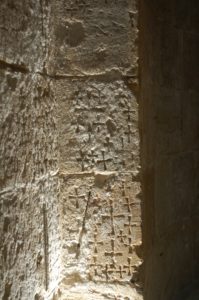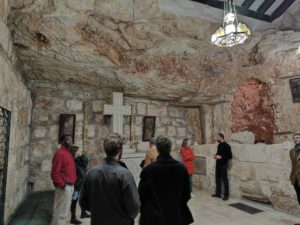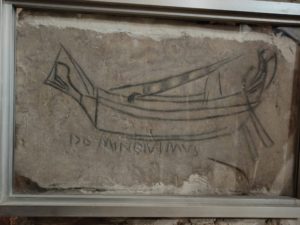Many treasures are hidden inside the Church of the Holy Sepulcher. On the fringes of the classic walk that takes the pilgrim from Calvary to the Tomb of Our Lord, with a stop at the Stone of Unction, there are a good number of chapels that commemorate the events of the Passion, such as that of the Flagellation and that of Saint Longinus – the centurion who cut open the Redeemer’s side with his spear. In between those chapels, a stairwell descends into the Chapel of Saint Helena. On the walls of that stairwell one can see some crosses engraved in the stone by pilgrims from antiquity.

Crosses photo by Henri Gourinard
To the left of said chapel, a door opens into a narrow corridor that descends towards a chapel that has been chiseled into the stone. It is the Armenian Chapel of St. Vartan. In one of its walls, archeologist have found graffiti representing an old ship with its mast collapsed – or damaged by a storm – and an inscription in Latin which reads: Domine ivimus, which can be translated as “Lord, we have arrived!”

Chapel of St. Vartan photo by Fernando Gilabert

Chapel of St. Vartan photo by Fernando Gilabert
To which Lord does the graffiti author refers? We know by St. Jerome that emperor Hadrian had ordered a temple to Jupiter built on top of the tomb of Jesus and another smaller one at Golgotha dedicated to Venus. Archeologists believe that the wall where the graffiti is found belongs to a retaining wall for the latter temple commissioned by Hadrian.
Could it be then that the visitor dedicated the graffiti to Jupiter as a sort of ex voto, or could it be for Jesus Christ? The text written under the ship can give us an answer: according to the erudite, its author took inspiration from the first verse of Psalm 121 (122), a psalm that the pilgrims to Jerusalem used to pray as they were nearing the Temple – the House of the Lord.
The text of the Vulgate reads: Laetatus sum in his quae dicta sunt mihi in domum Domini ibimus (I rejoiced when they said to me, “Let us go to the house of the LORD.”). If the interpretation of this archeological finding is correct, we are before a larger discovery: proof of the veneration of the place where the Resurrection took place by Christians from all over the Roman Empire before Constantine built his basilica.
By Henri Gourinard
